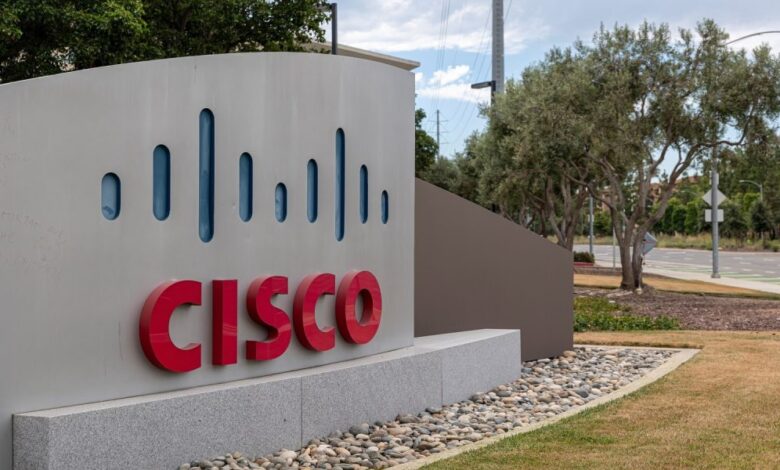Artificial Intelligence a Billion Dollar Play for Cisco Systems Inc.

Artificial Intelligence, a market that comprises several cutting-edge technology paradigms of our times, including computer vision, AI robotics, machine learning, autonomous and sensor technology, natural language processing, and more, is set for exponential growth in the near future. Even moderate estimates show that the global market size of AI is poised for more than 28% annual growth between 2024 and 2030, from US$184 billion to nearly US$827 billion.
It must come as no surprise that AI will impact every possible industry segment in the days to come, including healthcare, finance, manufacturing, business and legal services, transportation, security, energy, media and entertainment, retail, and more.
It is also no wonder that global businesses are deploying as many resources and research as possible to prepare themselves and reach a comfortable position where they can sustainably leverage this growth. One of the prime examples of such strategic long-term thinking comes from Cisco.
CISCO Geared Up with Proposed Investment Amounting to US$1 Billion in AI Startups
Cisco”s investment plan is quite specific and targeted. It will invest in companies working towards delivering ‘secure and intelligent’ AI services. The company has already committed around one-fifth of the proposed investment in companies like Mistral AI, Scale AI Inc., and Cohere Inc.
In the coming segments, we will look into these companies and the kind of solutions they develop.
Mistral AI: The declared mission of Mistral AI is to ‘make frontier AI ubiquitous and provide tailor-made AI to all the builders.’ Cisco’s press release about its investment commitment in Mistral AI positions it as a Paris-based global brand that specializes in generative AI. It caters to businesses with an open and responsible approach and vision.
More specifically, Mistral has three open-source models and three optimized models. In addition to these two categories, Mistral’s portfolio includes Codestral. As their category name suggests, open-source models are available for free under Apache 2.0, a fully permissive license that allows the use of the models anywhere without any restriction.
The optimized models are meant for commercial purposes and are available via Mistral’s flexible deployment modes. Codestral is an open-weight generative AI model explicitly designed for code generation.
When it comes to security, La Plateforme, the platform through which developers can access all Mistral AI’s models, is secure by design. The user data is encrypted at rest (AES256) and in transit (TLS 1.2+).
Scale AI: Cisco summarizes Scale AI’s services in the ‘secure and intelligent’ AI services space as a data-centric, end-to-end platform providing training and validation for AI applications. Cisco’s involvement in Scale AI was as part of the latter’s series F fundraising round, where Scale AI closed a US$1 billion financing transaction at a US$13.8 billion valuation.
While Scale AI is known for its autonomous data engine and public sector data engine, it is also credited with partnering with OpenAI in the first experiments of Reinforcement Learning with Human Feedback (RLHF) on GPT-2. Moreover, it works on the White House-supported DEFCON 31 red-teaming event and with the U.S. Department of Defense on the evaluation, testing, and red-teaming of LLMs.
In the future, Scale AI wants to build a data foundry that will lead to an abundance of AI-ready data. It also wants to focus on setting up frontier data that will help developers deal with complex reasoning, multimodality, and more. Additionally, the company seeks to formulate an evaluation system that will enable the measurement of AI in building confidence, driving adoption, and scaling impact.
Cohere AI: Optimized for enterprise generative AI, search and discovery, and advanced retrieval, Cohere provides security-focused frontier, large language models (LLMs), and industry-leading Retrieval-Augmented Generation (RAG) capabilities.
Cohere’s Command models, for instance, are built so that companies can leverage them to build production-ready, scalable, and efficient AI-powered applications. Cohere’s embedding model is compatible with more than 100 languages. Cohere is enterprise-grade AI deployment-ready on any cloud or on-premises, including solutions like AWS, Google Cloud, Oracles, and more.
While these are the major investment commitments from Cisco’s US$1 billion AI startup fund, the company has been a pro at making AI investments. Over the past years, it has made more than 20 AI-focused acquisitions and investments, augmenting its GenAI and Machine Learning capabilities and integrating AI across its brand portfolio.
According to Mark Patterson, Cisco’s Chief Strategy Officer:
“For more than 30 years, Cisco Investments has invested and partnered with hundreds of companies to drive innovation both within Cisco’s core markets and in new strategic areas.”
While speaking specifically about the AI investments, Patterson said:
“Our recent investments in generative AI companies align perfectly with this long-standing strategy. At Cisco, we believe we are well-positioned to be the best strategic partner for our customers in the AI era as they look to build, secure, and power AI. In addition to building essential technology to connect, secure, and advance AI, Cisco is committed to investing in the broader AI ecosystem to more effectively meet our customers’ needs.”
Cisco’s commitment to an AI-powered future is so robust and intense that the company does not only want to remain an external investor. It will work on product collaborations that will allow Cisco to innovate alongside its partners. It also aims to become an agnostic provider and platform player in AI.
While characterizing the fund and speaking about its specific formation objectives, Derek Idemoto, SVP of Corporate Development and Cisco Investments, had the following to say:
“This fund represents our unwavering commitment to AI and innovation and to the entrepreneurs and visionaries who are defining the next wave of technology.” The establishment of our $1 billion AI investment fund is a testament to our commitment to the transformative power of artificial intelligence and its potential to redefine industries globally.”
Click here to learn why 2023 was a breakout year for AI.
Cisco’s AI Efforts
While the forward-looking investments will help Cisco consolidate its position in the AI space, Cisco is already a provider in the domain with its services targeted towards infrastructure scaling, securing the organization, deriving insights from data, offering productivity booster software, and more.
In the first week of June this year, Cisco announced a cutting-edge AI cluster solution with NVIDIA for the data center that will be transformative for how customers have built, managed, and optimized their infrastructure and software so far.
The cluster solution, Cisco Nexus Hyper Fabric, is cloud-operated and comes with features such as full-stack AI, intuitive cloud management, and hyper-performance. Its purpose is to guide customers through the entire lifecycle from value creation to realization across all the clusters.
At the same time, Cisco announced new capabilities across its Security Cloud. Cisco had earlier announced its solution, hyper shield, intended to defend modern, AI-scale data centers.
While elaborating on the potential benefits of Cisco Hypershield, Chris Konrad, Vice President of Global Cyber, World Wide Technology, had the following to say:
“The promise of what Cisco Hypershield will deliver is a game-changer for how our customers will be able to close the exploit gap and achieve segmentation that adapts and learns. Along with new AI-powered management through Security Cloud Control and the quality innovation we continue to see in Cisco’s firewall portfolio, we can deliver an unparalleled customer outcome coupled with our services capabilities and expertise.”
Relevant to mention here, World Wide Technology is a well-known player in the domain of digital technology that helps IT and businesses undergo their transformative journeys.
Following the launch of the solution, Cisco announced Hypershield support for AMD Pensando DPUs, which is targeted for availability in Cisco Unified Computing System (UCS) servers and from other leading server vendors by the end of 2024.
Security Cloud Control, Cisco’s new AI-native management architecture, will help configure, manage, and monitor the entire Cisco Security Cloud. The architecture will help go beyond AI assistants to proactively surface actionable insights and automate resolution across hybrid environments. Customers will benefit from streamlined policies that come with optimal configuration setups.
Recently, Cisco also announced its new software, the 7.6 version of Firewall Threat Defense (FTD), for all its physical and virtual firewalls. FTD 7.6 leverages AI to prevent zero-day threats. It has application control over 70 generative AI steps that secure sensitive information, streamline branch network rollouts, and support zero-touch provisioning.
Cisco’s AI-Focused Acquisition of Splunk
Since we are discussing Cisco’s AI-focused investments, we must look into the acquisition of Splunk.
In March 2024, Cisco completed the acquisition of Splunk for $157 per share in cash, representing approximately $28 billion in equity value. While speaking about the synergy that the acquisition would bring in, Chuck Robbins, Chair and CEO of Cisco had the following to say:
“We are thrilled to officially welcome Splunk to Cisco. As one of the world’s largest software companies, we will revolutionize the way our customers leverage data to connect and protect every aspect of their organization as we help power and protect the AI revolution.”
At a more functional level, the ‘transformative combination’ of Splunk and Cisco aimed to achieve four objectives:
- Enabling organizations with the infrastructure to power AI
- Equipping organizations with the data to develop AI
- Empowering organizations with a top-notch security platform to protect their AI efforts
- Developing an observability platform to monitor and manage AI in real-time
When speaking about the potential of the partnership, Stephen Elliot, Group Vice President of I&O, Cloud Operations, and DevOps at IDC, said:
“With the close, Cisco has created a unique set of solutions for networking, security, and operations executives in the market. When you add that to their channel and AI investments, customers should be considering the higher levels of business value that can now be unlocked.”
Cisco Empowering Webex with AI
One of Cisco’s most well-known solutions is Webex. It is a teamwork, collaboration, and customer-experience solution that offers all necessary services, including calling, meetings, messaging, webinars, events, and video messaging.
Cisco has now empowered this solution with AI Assistants for the Webex Contact Center. Features in the beta version would include summaries with native transcription for virtual agents and dropped call summaries.
Later this year, Cisco will introduce suggested responses and automated wrap-up summaries, increasing agent efficiency and response accuracy. This will lead to less customer hold time and higher resolution rates.
Another new feature to become available later this summer would help businesses enable automated actions before, during, and after calls to mitigate the impact of agent burnout. For business stakeholders, the AI assistant would offer new features like topic analytics that will help identify top call drivers and create automated workflows for the most requested topics. The feature will help optimize proactive outbound communications and self-service options.
Cisco gathered feedback from early adopters of the contact center to assess the efficiency enhancement. The reports were more than promising.
- 80% of the call centers said that they could reply more accurately with suggested responses
- 93% said that they could get up to speed with customer history and context faster with summaries
- 80% said that they had clearer, distraction-free conversations with noise removal and voice optimizations
- Compatible with more than 100 languages, the AI assistant also saved 80% of the time on note-taking, action items, listening to recordings, and catching up on messages
Concluding Thoughts
Cisco has adopted a 360-degree strategy to implement its AI vision and augment its leadership in this space. The strategy is not only about inorganic growth. While it is about making investments in companies that are developing breakthrough solutions for the future, it is also about continuously evaluating existing solutions and consistently empowering them with AI. The strategy is, therefore, a prudent mix of looking inward and outwards, resulting in an optimal blend of organic and inorganic growth.
The fund could be worth US$1 billion as of now. But Cisco’s benefits from enhancing the efficiency, performance, and value of its services would be much more than that.
Click here to learn all about investing in artificial intelligence (AI).



